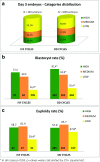Euploid embryos selected by an automated time-lapse system have superior SET outcomes than selected solely by conventional morphology assessment
- PMID: 30030710
- PMCID: PMC6133820
- DOI: 10.1007/s10815-018-1265-7
Euploid embryos selected by an automated time-lapse system have superior SET outcomes than selected solely by conventional morphology assessment
Abstract
Purpose: We investigated if automated TLI selection may be a valuable strategy to identify those euploid embryos with the best chances of success.
Methods: This is a unicentric and retrospective study involving 244 patients undergoing preimplantational genetic screening (PGS) cycles with autologous oocytes or oocyte donation (OD) with single euploid embryo transferred. We examined euploid embryos selected for transfer based on morphology evaluation alone (PGS-only; control group) or by assessment using an automated TLI system (Eeva™; PGS-TLI group).
Results: In both, autologous oocytes and OD patients, significantly better implantation and clinical and ongoing pregnancy rates were obtained in the PGS-TLI group when euploid embryos with high implantation potential as predicted by the automated TLI System (Eeva™) were transferred compared with the PGS-only group. This improvement was also observed when only transfers of good morphological quality embryos were compared. TLI categories showed significant differences on blastocyst formation and euploidy rate.
Conclusions: Automated TLI combined with PGS is a useful prognostic tool to identify euploid embryos with the highest potential for implantation and pregnancy. Further, these results provide evidence that a healthy pregnancy does not only depend upon normal chromosomal status.
Keywords: Automated time-lapse imaging; In vitro fertilization; Oocyte donation; Pregnancy rates; Preimplantation genetic screening.
Conflict of interest statement
The authors declare that they have no competing interests.
Figures


Comment in
-
Lack of evidence to support the superiority of TLI over conventional morphology to select among euploid embryos determined by PGT-A.J Assist Reprod Genet. 2019 Aug;36(8):1757-1758. doi: 10.1007/s10815-019-01514-w. Epub 2019 Jun 25. J Assist Reprod Genet. 2019. PMID: 31240429 Free PMC article. No abstract available.
References
-
- De Sutter P, Gerris J, Dhont M. A health-economic decision-analytic model comparing double with single embryo transfer in IVF/ICSI: a sensitivity analysis. Hum Reprod. 2003:1361. - PubMed
-
- Bromer JG, Ata B, Seli M, Lockwood CJ, Seli E. Preterm deliveries that result from multiple pregnancies associated with assisted reproductive technologies in the USA: a cost analysis. Curr Opin Obstet Gynecol [Internet]. 2011;23:168–173. Available from: http://ovidsp.ovid.com/ovidweb.cgi?T=JS&PAGE=reference&D=emed10&NEWS=N&A... - PubMed
-
- Wong KM, Mastenbroek S, Repping S. Cryopreservation of human embryos and its contribution to in vitro fertilization success rates. Fertil Steril [Internet]. Elsevier Inc.; 2014;102:19–26. Available from: 10.1016/j.fertnstert.2014.05.027 - PubMed
MeSH terms
LinkOut - more resources
Full Text Sources
Other Literature Sources
Molecular Biology Databases

